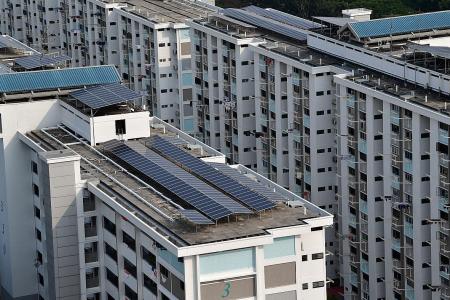Singapore aims to power 350,000 homes by 2030 with solar energy
Target: Generate power for 350k homes by 2030
Singapore wants to soak up more energy from the sun, amid growing global awareness on how fossil fuels are contributing to climate change.
By 2030, Singapore wants its solar capacity to be more than seven times as high as it is now, and increase the current 260 megawatt-peak (MWp) of installed solar capacity to 2 gigawatt-peak (GWp).
This is enough to meet the annual power needs of around 350,000 households in Singapore, or about 4 per cent of Singapore's total electricity demand today.
Solar energy contributes less than 1 per cent to Singapore's total energy mix. More than 95 per cent comes from natural gas, the cleanest form of fossil fuel.
The new 2GWp target for Singapore was outlined by Minister for Trade and Industry Chan Chun Sing yesterday at the opening of the Singapore International Energy Week at the Sands Expo and Convention Centre.
Solar is the most viable renewable energy option for Singapore, but harnessing it to power the nation is not easy.
Singapore's small size, the intermittency of sunshine due to cloud cover and urban shading, and cost are some challenges.
In the early 2000s, Singapore had switched from oil to natural gas - a cleaner fuel that Singapore now imports in liquefied form from all over the world and in gaseous form through pipes from Indonesia and Malaysia - to power the nation.
The next step would be to increase the adoption of solar here, Mr Chan said.
In the longer-term, Singapore could be plugged into a regional power grid, which would increase its energy security, even as the Republic invests in research and development into other low-carbon technologies that, unlike solar, have yet to become commercially viable.
This includes research on the possibility of using "green" hydrogen as a fuel and on carbon capture utilisation and storage technologies - innovations that could suck carbon dioxide out of the air and convert it into useful products, such as chemicals and building materials.
To meet the 2030 solar target, the Government wants to maximise deploying solar panels on available surfaces, including rooftops, reservoirs, offshore sea space, and on the vertical surfaces of buildings.
Mr Chan said Singapore will also invest more in researching energy storage systems. These function as batteries when hooked up to solar systems, helping to overcome the challenge of intermittent sunshine.
Experts say Singapore's target of having 2GWp of installed solar capacity by 2030 is ambitious but achievable.
Professor Subodh Mhaisalkar, executive director for the Energy Research Institute at the Nanyang Technological University, said solar panels had to be deployed on a larger scale.
He said: "Other than deploying solar panels on Housing Board rooftops, we will need very large contributions from other sources, including residential and industrial buildings, and also deploy solar panels on infrastructure such as walkways and depots, on building facades and on water bodies such as reservoirs and the sea."
FOR MORE, READ THE STRAITS TIMES
Get The New Paper on your phone with the free TNP app. Download from the Apple App Store or Google Play Store now


